Your child's meal plan must be flexible and realistic, while taking into account your child's lifestyle, likes and dislikes.
The main goals of the meal plan are:
- to satisfy your child’s appetite
- to promote norm al growth and development
- to balance carbohydrates with insulin
- to be easy to follow so your family can incorporate it into daily life.
How do foods affect blood sugar?
Ask people what they know about diabetes and chances are they will say, "That is the disease where you cannot eat sugar, right?" In fact, people with diabetes can and do eat sugar. The catch is that they have to pay closer attention to what kinds of sugar they eat, how much they eat, and when they eat it. Many foods have some form of sugar. Learning about how much sugar different foods contain is an important part of diabetes nutrition.
The foods we eat provide many nutrients, which are divided into three main food groups: proteins, fats, and carbohydrates. These are called macronutrients. Vitamins and minerals are micronutrients. Many foods are a combination of protein, fat, and carbohydrates.
Carbohydrate is sometimes shortened to "carb".
Reading food labels
Understanding food labels and nutrition facts
A healthy diet must balance appropriate amounts of protein, fats, and carbohydrates, all of which play an important role in healthy growth and development. The best way to do this is to eat a variety of foods containing each of these three macronutrients.
Reading labels for carbohydrate counting
There are three steps to approaching labels when counting carbohydrates:
- Find the serving size of the food (on top).
- Determine the total amount of carbohydrates for the serving size, which is listed first. This includes fibre, sugar, and starch (unlike sugar and fibre, starch is not listed separately).
- Subtract the fibre and sugar alcohols (present in "sugar-free" or "no added sugar" products) from the total amount of carbohydrates. This will give you the amount of available carbohydrates.
Remember this formula when looking at nutrition labels:
Number of grams of carbohydrates - number of grams of fibre - number of grams of sugar alcohols = available carbohydrates.
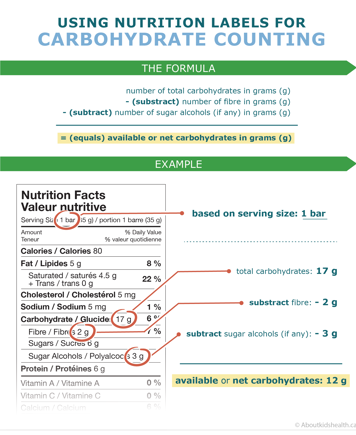
Foods that contain carbohydrates
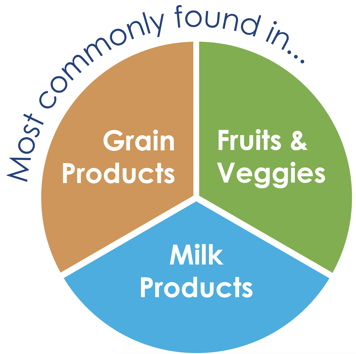
Here are some examples of foods that contain carbohydrates:
- starches: breads, pasta, rice, grains, cereals, corn, potatoes, cookies, crackers
- fruits and vegetables: fruits and 100% fruit juices (including tomato juice); sweet vegetables, such as turnip, squash, carrots, peas, beets, parsnip
-
dairy products: milk, yogurt
- sugary foods: refined sugar, honey, molasses, syrups; jams and jellies; candy; chocolate; regular soft drinks.
It is important to consider all carbohydrates in diabetes meal plans. Even though "carbohydrate" means "sugar", they do not always taste sweet. This is the only group that directly and immediately raises blood sugar levels. Carbohydrates are an essential source of energy. Some carbohydrate-containing foods cause the blood glucose level to rise rapidly; others have a more gradual effect.
People with diabetes can eat all carbohydrates, including sugar and foods containing added sugar, such as candy and chocolate, in small amounts. These sugars should make up no more than 10 per cent of their total calorie intake. This means that if your child eats 1000 calories a day, the part from added sugars (simple carbohydrates) should not be more than 100 calories in a day. Learning how to incorporate such foods into the diet makes the meal plan easier to follow.
Other foods, including proteins and fats, may (but not always) contain carbohydrates, which must also be considered. This is why reading food labels matters.
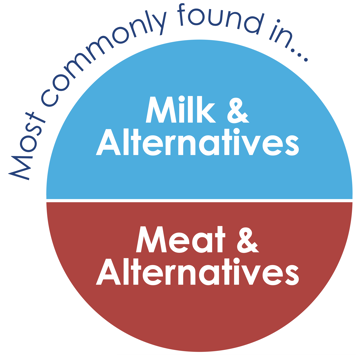
Foods that contain protein
Here are some examples of foods that contain protein:
- meat, poultry, fish, shellfish
- eggs
- legumes: nuts, beans, lentils, peanuts and peanut butter, tofu
- milk, cheese, cottage cheese, other dairy products.
Protein does not directly raise the level of blood sugar. Proteins help with healing and tissue repair. Protein foods also provide essential vitamins and minerals.
Foods that contain fats

Fats are sometimes called lipids. Here are some examples of foods that contain fats:
- all oils: butter, lard, shortening, margarine
- meat: red meat and poultry
- fish and shellfish
- dairy products: butter, milk, cream and cream products, cheese, and cheese products
- eggs
- other: salad dressings (low fat and regular), gravy, nuts, seeds, olives, coconut, avocado.
Like protein, fats do not directly raise the level of blood sugar. Fats are an integral part of a well-balanced diet as they provide essential building blocks for growth and development.
During prolonged starvation or undernourishment, the body can break fats down into sugar. However, this is not healthy, as fats break down and produce ketones and promote diabetic ketoacidosis (DKA).
Type of fat (fatty acid)
Saturated
What it looks like at room temperature
Solid
Effect on the body
Bad
- Raises the level of "bad" (LDL) cholesterol in the blood
- Some saturated fats have been linked to a higher risk of heart disease
Foods that contain this type of fat
- Lard
- Shortening
- Butter
- Animal products such as meat, eggs and milk

Polyunsaturated
What it looks like at room temperature
Solid or liquid
Effect on the body
Good
- Helps lower cholesterol
- Omega-3 helps prevent clotting of blood and lowers the risk of heart disease
Foods that contain this type of fat
Polyunsaturated fat includes omega-3 and omega-6 fatty acids
Omega-3
- Fatty fish such as salmon, mackerel, trout, herring and sardines
- Oils and margarines
- Omega-3 enriched eggs and milk products
Omega-6
- Safflower, sunflower, and corn oils
- Some soft non-hydrogenated margarines
- Avocados
- Eggs
- Almonds, pecans, brazil nuts, sunflower seeds and sesame seeds
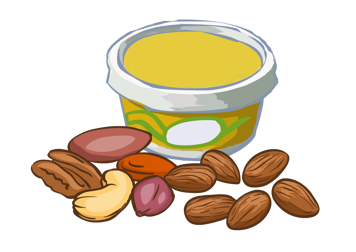
Monounsaturated
What it looks like at room temperature
Solid or liquid
Effect on the body
Good
- Helps lower cholesterol
Foods that contain this type of fat
- Olive oil
- Peanut oil
- Canola oil
- Soft non-hydrogenated margarines
- Avocados and nuts
- Almonds, pistachios, pecans and cashews
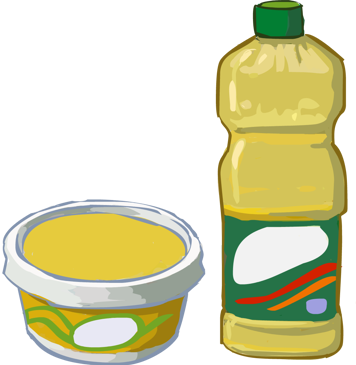
These three types of fats are found in different combinations in foods. Try to favour foods that contain polyunsaturated or monounsaturated fats. You should aim to maintain normal blood fat (lipid) levels in the body. High levels, however, add to the risk of developing com plications later in life such as heart disease.
Foods that contain no carbohydrates, protein nor fats
Some vegetables, such as lettuce, celery, cucumbers, and peppers, fall outside the three food categories. Since they contain very small amounts of carbohydrates, protein and fats, they can be considered as "free foods". They are essential because they add flavour and variety, fibre, and micronutrients such as vitamins and minerals, to the diet.